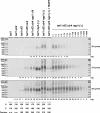Multiple pathways inhibit NHEJ at telomeres
- PMID: 18451106
- PMCID: PMC2335312
- DOI: 10.1101/gad.455108
Multiple pathways inhibit NHEJ at telomeres
Abstract
The nonhomologous end-joining (NHEJ) repair pathway is inhibited at telomeres, preventing chromosome fusion. In budding yeast Saccharomyces cerevisiae, the Rap1 protein directly binds the telomere sequences and is required for NHEJ inhibition. Here we show that the Rap1 C-terminal domain establishes two parallel inhibitory pathways through the proteins Rif2 and Sir4. In addition, the central domain of Rap1 inhibits NHEJ independently of Rif2 and Sir4. Thus, Rap1 establishes several independent pathways to prevent telomere fusions. We discuss a possible mechanism that would explain Rif2 multifunctionality at telomeres and the recent evolutionary origin of Rif2 from an origin recognition complex (ORC) subunit.
Figures





Similar articles
-
Rif2 protects Rap1-depleted telomeres from MRX-mediated degradation in Saccharomyces cerevisiae.Elife. 2022 Jan 19;11:e74090. doi: 10.7554/eLife.74090. Elife. 2022. PMID: 35044907 Free PMC article.
-
Rap1 prevents telomere fusions by nonhomologous end joining.EMBO J. 2005 Sep 7;24(17):3117-27. doi: 10.1038/sj.emboj.7600778. Epub 2005 Aug 11. EMBO J. 2005. PMID: 16096640 Free PMC article.
-
Structural and functional studies of the Rap1 C-terminus reveal novel separation-of-function mutants.J Mol Biol. 2008 Jul 11;380(3):520-31. doi: 10.1016/j.jmb.2008.04.078. Epub 2008 May 17. J Mol Biol. 2008. PMID: 18538788 Free PMC article.
-
Ku Binding on Telomeres Occurs at Sites Distal from the Physical Chromosome Ends.PLoS Genet. 2016 Dec 8;12(12):e1006479. doi: 10.1371/journal.pgen.1006479. eCollection 2016 Dec. PLoS Genet. 2016. PMID: 27930670 Free PMC article.
-
Tying up loose ends: nonhomologous end-joining in Saccharomyces cerevisiae.Mutat Res. 2000 Jun 30;451(1-2):71-89. doi: 10.1016/s0027-5107(00)00041-5. Mutat Res. 2000. PMID: 10915866 Review.
Cited by
-
A STUbL wards off telomere fusions.EMBO J. 2013 Mar 20;32(6):775-7. doi: 10.1038/emboj.2013.39. Epub 2013 Feb 22. EMBO J. 2013. PMID: 23435563 Free PMC article.
-
Dicentric breakage at telomere fusions.Genes Dev. 2010 Apr 1;24(7):720-33. doi: 10.1101/gad.571510. Genes Dev. 2010. PMID: 20360388 Free PMC article.
-
Rif2 protects Rap1-depleted telomeres from MRX-mediated degradation in Saccharomyces cerevisiae.Elife. 2022 Jan 19;11:e74090. doi: 10.7554/eLife.74090. Elife. 2022. PMID: 35044907 Free PMC article.
-
DNA Damage Response-Associated Cell Cycle Re-Entry and Neuronal Senescence in Brain Aging and Alzheimer's Disease.J Alzheimers Dis. 2023;94(s1):S429-S451. doi: 10.3233/JAD-220203. J Alzheimers Dis. 2023. PMID: 35848025 Free PMC article. Review.
-
Inhibition of MRN activity by a telomere protein motif.Nat Commun. 2021 Jun 22;12(1):3856. doi: 10.1038/s41467-021-24047-2. Nat Commun. 2021. PMID: 34158470 Free PMC article.
References
-
- Amiard S., Doudeau M., Pinte S., Poulet A., Lenain C., Faivre-Moskalenko C., Angelov D., Hug N., Vindigni A., Bouvet P., et al. A topological mechanism for TRF2-enhanced strand invasion. Nat. Struct. Mol. Biol. 2007;14:147–154. - PubMed
-
- Astrom S.U., Okamura S.M., Rine J. Yeast cell-type regulation of DNA repair. Nature. 1999;397:310. - PubMed
-
- Bae N.S., Baumann P. A RAP1/TRF2 complex inhibits nonhomologous end-joining at human telomeric DNA ends. Mol. Cell. 2007;26:323–334. - PubMed
-
- Bowers J.L., Randell J.C., Chen S., Bell S.P. ATP hydrolysis by ORC catalyzes reiterative Mcm2–7 assembly at a defined origin of replication. Mol. Cell. 2004;16:967–978. - PubMed
-
- Buck S.W., Shore D. Action of a RAP1 carboxy-terminal silencing domain reveals an underlying competition between HMR and telomeres in yeast. Genes & Dev. 1995;9:370–384. - PubMed
Publication types
MeSH terms
Substances
LinkOut - more resources
Full Text Sources
Molecular Biology Databases
